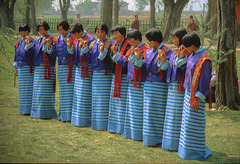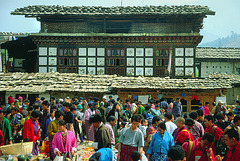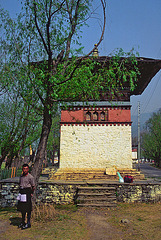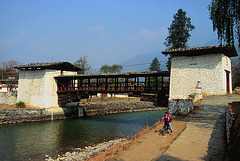Wolfgang's photos
Dzongchung at Punakha Dzong
| |
|
|
|
Its located beside the Punakha Dzong and is older then the all Dzongs in Bhutan which were built in 17th Century by Lama Zhamdrung Ngawang Namgyal.
In 1994 a catastrophic flood damaged the Dzongchung although the Jhou (Buddha image) was miraculously saved. Originally built in 1374 by the great sage Dupthop Ngagi Rinchhen, the Dzongchung was restored in 1996 and consecrated by His Holiness, Geshe Gueden Rinchhen, the 69th Je Khenpo. Besides enlarging the plinth area to 1,500 square feet from the previous 590 square feet a large retaining wall, 25 to 35 feet in height, was constructed around the Dzongchhung, using stone masonry and cement mortar.
Punakha Dzong in the sunset light
| |
|
|
By tradition, dzongs are constructed without the use of architectural plans. Instead construction proceeds under the direction of a high lama who establishes each dimension by means of spiritual inspiration.
In previous times the dzongs were built using corvee labor which was applied as a tax against each household in the district. Under this obligation each family was to provision a decreed number of workers to work for several months at a time in the construction of the dzong.
At the confluence of Mo Chhu and Po Chhu
| |
|
|
The mother river and the father river flow together. At the background can see the Punakha Dzong behind the forest.
Traditional masks sold at DochuLa
| |
|
This mask was to sell for foreign visitors. The phallus nose is a symbolic meaning for indicating a balance between male and female creative energies.
The phallic symbol is as popular as it has ever been.
It comes in different shapes and sizes, carved in wood, metal, stone and cloth. It is painted on walls and hung from the eaves of houses and displayed in various forms during some traditional ceremonies.
In Bhutan the phallus is an integral part of ceremonies observed by communities, commonly used to ward off evil spirits and counter evil.
It is sometimes called Kharam shing or Mikha, meaning a piece of wood to counter the evil tongue and eye, Gulang or Wangchu Chenpo, a reference to Lord Shiva, Wangchu Chenpo pho taag, meaning the male symbol of Lord Shiva, or simply Zur shing, meaning a piece of wood that hangs from the eaves.
But contrary to the popular perception, the phallus has a world of meaning beyond its obvious symbolism to ward off evil influences.
Speaking to Kuensel, a Bhutanese scholar said that the real significance of the phallus has been perverted by popular belief.
“The phallus is nothing but an artistic folk device by which human beings confront the issue of male ego,” he said. “In plain terms it is an attempt to do away with the male ego since the phallus in its warped form reminds of problems of male ego.”
Tashi Choe Dzong and Gouvernment building complex…
| |
|
|
The "fortress of the glorious religion", was initially built in 1641 by Zhabdrung Nawang Namgyal. The present structure was rebuilt in 1965 by the third King, Jigme Dorji Wangchuck, when he chose Thimphu as his permanent capital. It houses the government and the central clergy of monks. It is open to the visitors during festivals, on weekends, and after office hours.
Its also the home of His Royal Highness Jigme Singye Wangchuck.
Crashed down chopper at Khao Phra Vihaan
| |
|
|
This helicopter crash site was up there on my trip up back in the 90's. It was a Thai army copter that crashed while bringing up some friend of either the Thai King or the Prime Minister, thats was local people say.
Way back to the first level
| |
|
The temple ruins here are not in the best of shape. There has been little restoration of the ruins themselves here over the years, actually, none at all. The Cambodians are very poor and do not spend any money toward upkeeping the ruins. Conversely at another Khmer ruin inside of Thailand, the Khao Phanom Rung temple complex, the Thais have restored the ruins with the help of the French archaeologists and the grounds are well kept, beautiful even, and very clean and pleasant.
Beside the historical path of Phra Vihaan
| |
|
|
The debris of a crashed Thai chopper still lie beside the ancient place. People tell different stories about the cause of the crash.
Remains of the first level
| |
|
As you can see a Cambodian flag now flies over the entrance to the ruins where a Thai flag once flew. There are many bitter feelings toward the Thai from the Cambodian people due to the amount of time the Thais held onto these ruins.
Relief of catching a "Nāga" snake
| |
|
|
In a Cambodian legend, the Nāga were a reptilian race of beings who possessed a large empire or kingdom in the Pacific Ocean region. The Nāga King's daughter married an Indian Brahmana named Kaundinya, and from their union sprang the Cambodian people. Therefore still Cambodians say that they are "Born from the Nāga".
An intersection in Thimphu
Dancing women in their traditional Kira
| |
|
The kira is the national dress for women in Bhutan. It is an ankle-length dress known as the kira which is clipped at the shoulder and tied at the waist. An accompaniment to the kira is a long-sleeved blouse which is worn underneath. Social status and class is determined by the texture, bright colours, and decorations embellishing the garments
At the Paro market
Chorten at the alley to the Paro bridge
| |
|
The Bhutanese word is Chorten, which means “the basis of offering”.
It is a symbol of enlightened mind, (the awakened mind, universal divinity) and the path to its realisation.
The Paro bridge
| |
|
|
The bridge to the Rinpung Dzong crosses the Paro River and got famous in a scenery in Bernardo Bertoluccis master work "Little Buddha".
Tiger's Nest Monastery with the fire destroyed par…
| |
|
|
|
One of the most sacrednyes in the Buddhist world, Taktshang was established in the eighth century by Guru Rinpoche. The guru in the wrathful form of Guru Dorji Droley subdued the evil spirits and then meditated in the Pelphug in Taktshang. Other saints who meditated in the cave include Milarepa, Phadampa Sangye, Machi Labdoenma, Thangthong Gyalpo and Zhabdrung Ngawang Namgyal. The main monastery around the Pelphug in Taktshang was constructed in 1692 by the great fourth Desi, Tenzin Rabgye. Between 1961 and 1965 it was renovated by Je Sheldrup Yoezer. The latest additions were made in 1982. The Taktshang monastery was severely damaged by fire on April 19, 1998, but the Dubkhang, the most sacred sanctum of the monastery, was found to be safe. Restoration work on the lhakhang began two years later after the fire because of the lona and the danger of loosened rocks from the cliffs overhead.
Dedicated to Guru Padmasambhava, this incredible monastery clings to the edge of a sheer rock cliff that plunges 900 meters into the valley below. The history states that Guru Padmasambhava, the tantrum mystic who brought Buddhism to Bhutan, had taken the wrathful form of Guru Dorje Droloe to subdue the evil and demon that were obstructing the spread of Buddhism in the Himalayas.
A fire destroyed a value part of the monastery in April1998. It was in restruction when we visited the Tiger's Nest at that time. Look at the photo I captured four years before:
Bhutanese little ladies in the yard of the monaste…
| |
|
|
... happy to get captures. I sent them a print copy to Paro and I got an answer to Bangkok.
Every time when I visited Bhutan, my first visit was to this amazing place which is located outside Paro just a few kilometers.
Rinpung Dzong in Paro
| |
|
|
Also known as " fortress of the heap of jewels ", it was built during the time of Shabdrung Ngawang Namgyal in 1646. The approach to the Dzong is through a traditional covered bridge called the Nemi Zam. A walk through the bridge to the Dzong, over a stone inlaid path, offers a good view of the architectural wonder of the Dzong as well as life around it. It is also venue of the Paro Tshechu, held once a year inspiring.


















